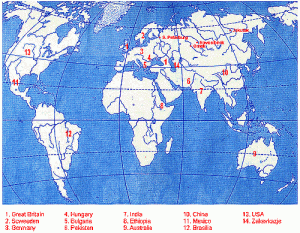Institute of Cytology and Genetics, SB RAS, Novosibirsk
Head of the Institute:
Vladimir K.Shumny, Academician of the RAS
10 Lavrentyeva Ave., Novosibirsk, 630090, Russia
Tel. (3832)-333526, Fax: (3832)-331278,
email: shumny@bionet.nsc.ru
Principal researchers:
T.A.Pshenichnikova, Laboratory of Wheat Cytogenetics
Project objectives
The aim of project is the development and maintenance of the genetically and cytologically marked collection specimens of wheat and its derivatives to be used for study of the genetic nature of biological diversity in cereals.
Background and significance of objectives
The vegetable kingdom of the Earth has been considerably changed by man. The most important creative result of his activity is the development of new plant species, which have enlarged the diversity of flora. Common wheat can be considered as a classic example because this species does not exist in the wild. During the evolution of the society, man developed a large amount of its specimens adapted to different environments, more than once attracting for this purpose wild relatives of common wheat. In such a way the biological diversity of the species have been considerably increased. But the common wheat samples are not only the “reservoir” of valuable genes by combining of which the further enlarging of diversity is possible. On their basis scientific means were elaborated as cytologically marked lines (aneuploids) which allow one to manipulate with chromosomes or their fragments, and purposefully construct the new genotypes.
In the 60-90s the collection of such lines was obtained in the Institute of Cytology and Genetics, SB RAS. On their basis using cytogenetic manipulations the lines with intervarietal and alien substitutions were developed. For obtaining new specimens such species of cereals were involved as: Secale cereale L., Triticum timopheevii Zhuk., Triticum polonicum L., aegilops tauschii Coss., Aegilops speltoides L., Triticum petropavlovskyi Udacz. et Migusch., Triticum sphaerococcum Perciv. The collection consists of more than 150 samples. Taking into account the number and diversity of the lines, it takes the second place in Eurasia among such collections, and some samples are unique. By use of it, such important biological characters as frost resistance, sensitivity to vernalisation and photoperiod, reaction to concentration of mineral elements in soil, different types of plant pigmentation were studied. The collection gives practically infinite possibilities for discovering the genetic nature of cereals diversity on different adaptive characters.
Research plan: approaches and methods
The periodical resowing of samples and storing of seeds under special conditions is necessary. Near ideal may be considered storing under low temperatures which allows to keep the samples without resowing for 10-15 years. The cytological study of progeny including special crosses of certain genotypes is necessary for testing line constancy. In a parallel study the molecular markers of different types will be used for the same purpose. The genetic and cytogenetic analysis will be applied for investigations of the genetic basis of biological diversity in wheat and other cereals, and molecular markers – for discovering evolutionary connections in relative genomes.
Expected results
The project envisages the maintenance in alive form and placing at concerned persons’ disposal the following collection specimens:
- the complete monosomic (2n=41) sets of lines developed for varieties Saratovskaya 29 (S29) and Diamant (Dm);
- 19 ditelosomic (2n=40+2t), 18 monotelosomic (2n=40+t) lines in S29; 22 ditelo- and 22 monotelosomic lines in Dm;
- 108 lines with intervarietal substitutions;
- 13 alien substitution lines and 11 alien addition lines;
- about 50 isogenic lines, including introgressions from wild wheat relatives.
In aneuploid lines and in lines with substituted chromosomes the cytological control will guarantee the correctness of chromosome numbering in wheat. The genetic nature of cereals diversity on some morphological and physiological characters of different systematic levels will be studied.
List of publications of participants related to the project
-
Pshenichnikova T.A., Maystrenko O.I. Inheritance of genes coding for gliadin proteins and glume colour introgressed into Triticum aestivum from a synthetic wheat. Plant Breeding. ñ 1995. ñ Vol. 114. ñ P. 501-504.
-
Arbuzova V.S., Efremova T.T., Laikova L.I., Maystrenko O.I., Popova O.M., Pshenichnikova T.A. The development of precise genetic stocks in two wheat cultivars and their use in genetic analysis // Euphytica. ñ 1996. ñ Vol. 89. P. 11-15.
-
Maystrenko O.I., Efremova T.T., Salina E.A., Shumny V.K. Discovery and study of non-manifestation of gene Sp1 for spring habit of rye in the lines with alien substitution of chromosome 5R(5A) in wheat // Proc. of RAS. ñ 1998. ñ Vol. 360. ñ P. 574-576. (in Russian).
-
Efremova T.T., Maystrenko O.I., Arbuzova V.S., Laikova L.I. Genetic analysis of glume colour in common wheat cultivars from the former USSR // Euphytica. ñ 1998. ñ Vol. 102. ñ P. 211-218.
-
Arbuzova V.S., Maystrenko O.I., Popova O.M. Development of near-isogenic lines of the common wheat cultivar ëSaratovskaya 29í // Cereal Research Communications. ñ 1998. ñ Vol. 26. ñ P. 39-46.
-
Efremova T.T., Maystrenko O.I., Laikova L.I. Development of alien substitution lines of wheat with rye chromosome 5R // Cereal Research Communications. ñ 1996. ñ Vol. 24. ñ P. 33-39.
-
Maystrenko O.I., Laikova L.I., Arbuzova V.S., Melnik V.M. The chromosomal location of the S1, S2 and S3 genes of induced spherococcoid mutations in common wheat // EWAC Newsletter, 1998. ñ P. 127-130.
-
Efremova T.T., Maystrenko O.I. Use of lines with intervarietal substitution of chromosomes in study of allelism in Vrn1 locus of common wheat // Genetica, 1996. ñ Vol. 32. ñ P. 259-261. (in Russian).

